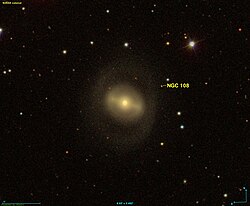| NGC 108 | |
|---|---|
 NGC 108 imaged by SDSS | |
| Observation data (J2000 epoch) | |
| Constellation | Andromeda |
| Right ascension | 00h 25m 59.73s [1] |
| Declination | 29° 12′ 43.4″ [1] |
| Redshift | 0.015801 [1] |
| Heliocentric radial velocity | 4737 km/s [1] |
| Distance | 220 Mly (67 Mpc) [2] |
| Group or cluster | NGC 108 group (LGG 5) |
| Apparent magnitude (V) | 12.1 [2] |
| Characteristics | |
| Type | (R)SB0+(r) [1] |
| Apparent size (V) | 2.7′ × 1.9′ [2] |
| Other designations | |
| UGC 246, MCG +05-02-012, PGC 1619 [1] | |
NGC 108 is a barred lenticular galaxy that is located at approximately 220 million light-years away in the constellation of Andromeda. It was discovered by German-British astronomer William Herschel on September 11, 1784. [2] [3]